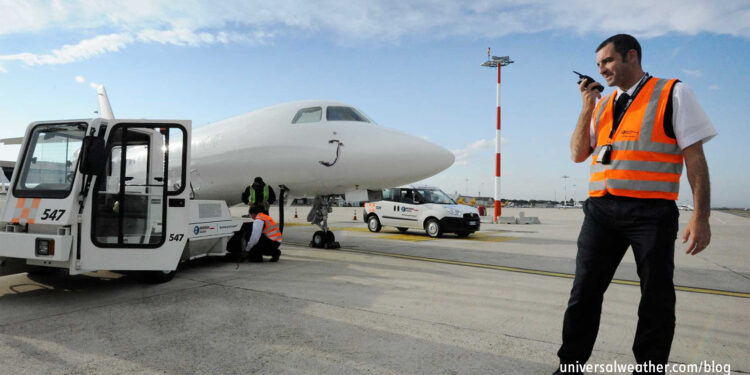Aircraft Ground Support Equipment Requirements: Part 1of 2 – Top Considerations

This business aviation blog post is part of a series on ground support equipment considerations for your flight.
Aircraft support equipment and supply considerations for destination airports are important pre-trip planning issues. Particularly when operating to remote or secondary/domestic airports this is a checklist item that should not be neglected.
The following is an overview of what you need to know:
1. Fuel availability
Always confirm fuel availability and what types of fuel are available locally. Is hydrant fuel available? Is all fuel delivery via fuel trucks and how many fuel trucks are available on the airfield? In some cases certain types of fuel may need to be brought in from off-airport, involving lead times and higher costs. At some locations fuel may need to be pumped from barrels while at other locations, such as the Galapagos Islands, it may be impossible to bring in fuel.
2. Towbars
Many locations, including airports in Brazil and India, require operators to have a towbar onboard before they’ll confirm aircraft parking. In other cases you’ll need a towbar simply to depart from an assigned parking stand. Not all local fixed-base operators (FBOs) and ground handlers carry all towbar types, particularly if you’re operating a less common type of general aviation (GA) aircraft, so it’s best to know before you go. Some operators always have a towbar head on board while others routinely carry the full towbar.
3. Ground power
Availability of ground power and ground power units (GPU) is always something to be mindful of – particularly if there are local restrictions on using your auxiliary power unit (APU) at destination. Some airports only permit you to use an APU at certain times while other locations, such as Nice (LFMN), only allow APU use for a few minutes after landing and prior to takeoff.
4. Airstairs, baggage loaders and lifts
External stairs are often required for large and widebody aircraft. In some cases, appropriate equipment may not be available at the planned destination. You may need to either arrange to bring in stairs from off airport or, in some cases, choose a different airport to operate into. For certain larger aircraft it’s also important to consider availability of baggage belt loaders and lifts for delivery of catering. Such equipment may be in limited supply at certain airports and/or may not be readily available during peak hours of local commercial airline activity.
5. Ladders and miscellaneous supplies
Particularly for larger aircraft – having appropriate ladders to put on engine covers or access engine cowlings is often a requirement. Depending on your aircraft you may also need to bring along, or locally source, external headsets to plug in to the exterior of your aircraft. Other considerations – do you have the required equipment/supplies at destination to clean the exterior of flight deck windscreens and/or to clean onboard linens, laundry, and china? While operators often assume that wheel chocks are always available, this may not be the case. There have been times when aircraft have been asked to bring their own chocks for travel to certain destination as no chocks were available during busy local event periods.
6. Oxygen availability
Oxygen may be difficult to source at many destinations due to local airport or countrywide restrictions, and ground handler storage capabilities. Particular restrictions may exist on replenishment of onboard oxygen, and/or there may be liability issues in terms of suppliers who may not be approved to service your aircraft type. At some locations, for example, local suppliers are able to replenish oxygen for scheduled commercial airlines but not for transient general aviation (GA) equipment.
7. Required additives
Note that fuel additives, such as PRIST®, are not always available at all locations. If you require this, it’s best to confirm in advance that it will be available on-site. You may need to bring PRIST® with you from another location. You may in some cases require other types of fluids for your aircraft. Will these supplies be available at your airport of destination? It’s always best to check in advance.
8. Cabin disinfectants
Many regions – including Australia, India, and parts of Africa – mandate that you treat your cabin with an insecticide spray prior to landing. Typically, the procedure is that you’ll disinfect the cabin at top of descent or immediately upon landing, prior to opening doors. You’ll then need to present the empty disinfectant spray can to your handler, or local airport authorities, on deplaning. Note that it’s often difficult to source these sprays, as the chemical mix may be controlled or restricted at many locations. In some cases you may need to make an additional stop in order to pick up a disinfectant spray can for later use. It’s best to research in advance which locations for your trip may require this and where you are able to obtain it.
9. Deicing fluids
For winter operations it’s important to confirm not only local availability of deice fluid but also what type/s of products is available on the airport. Some local deice fluids – this has been the case in certain parts of Russia – may be corrosive to aircraft paint. It’s always important to understand the local deice process, where it’s done on the airport and if long delays may be anticipated peak operating periods. Some aircraft, such as Hawkers, use a weeping-wing leading edge deice system and require replenishment of TKS, or other particular types of fluid.
Conclusion
Destinations that handle few GA aircraft often have limited support equipment/services and require longer planning lead times. Depending upon your destination, ground support equipment may need to be brought in and additional costs should be considered.
Stay tuned for Part 2, which covers planning tips for arranging ground support equipment for your flight.
Questions?
If you have any questions about this article or would like assistance planning for equipment you will need on your next flight, contact me at greglinton@univ-wea.com.




